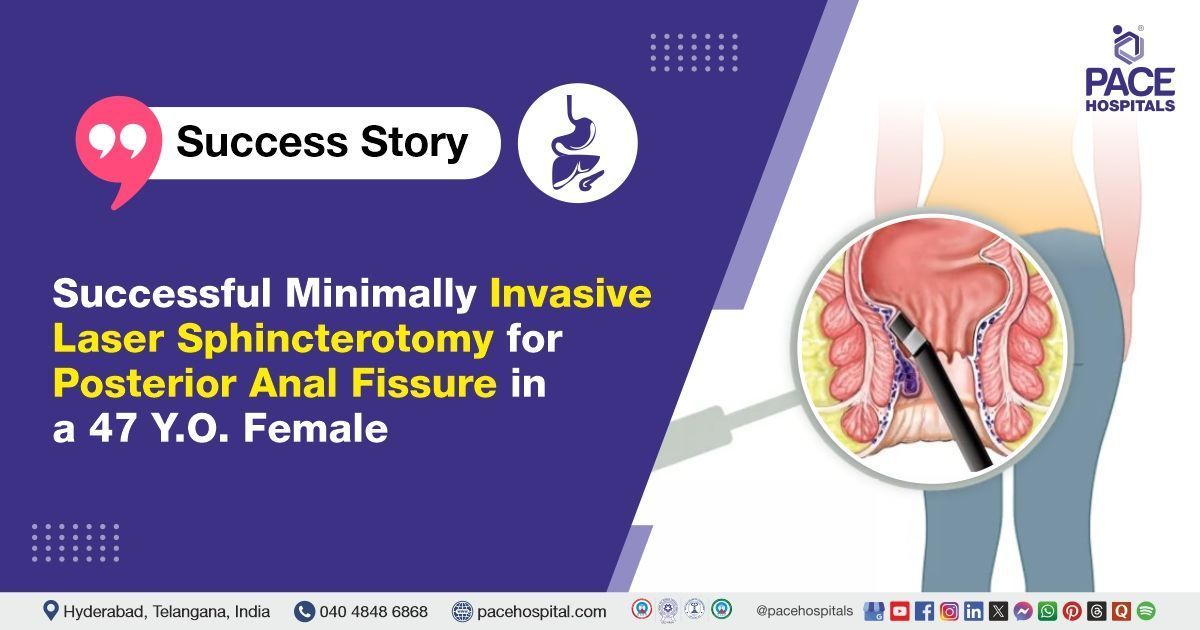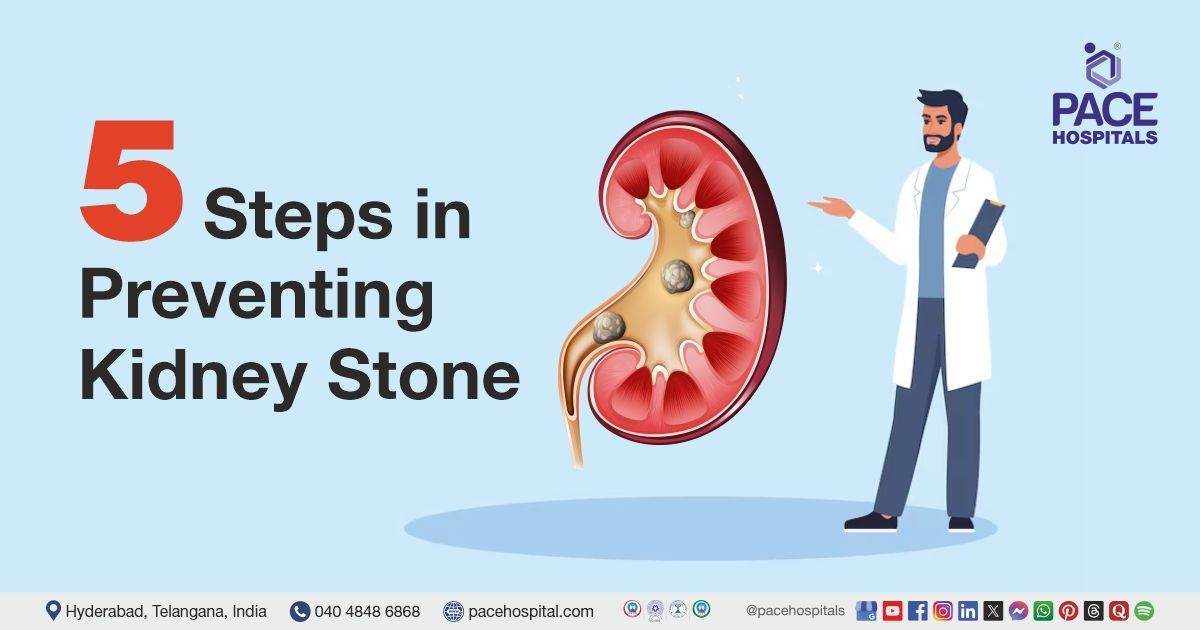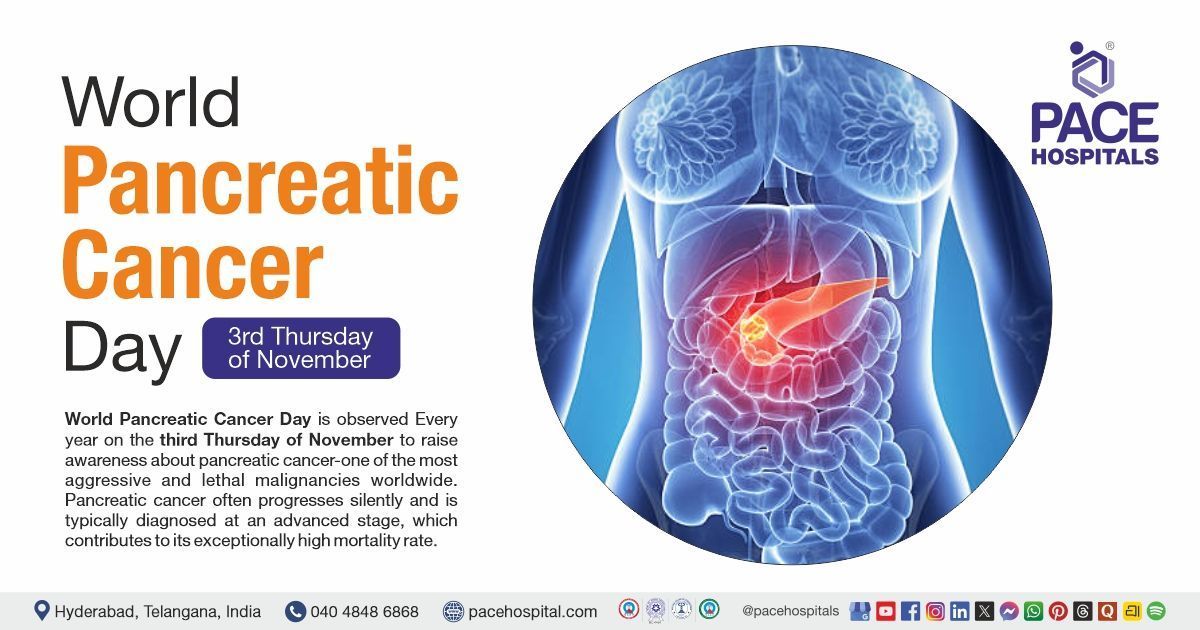Successful Minimally Invasive Laser Sphincterotomy for Posterior Anal Fissure in a 47-Y.O.
PACE Hospitals
The PACE Hospitals' expert Surgical Gastroenterology team successfully performed a Laser Sphincterotomy on a 47-year-old female patient diagnosed with a posterior anal fissure. The procedure was carried out to treat bleeding per rectum, painful defecation, and increased anal sphincter tone. The surgery was uneventful, and the patient was discharged in stable condition with appropriate medications and advice to follow a high-fiber diet.
Chief Complaints
A 47-year-old female patient, with a
body mass index (BMI) of 22.4, presented to the Surgical Gastroenterology Department at
PACE Hospitals, Hitech City, Hyderabad, with chief complaints of bleeding per rectum and painful defecation.
Past Medical History
The patient had no known history of hypertension or diabetes. The absence of comorbid conditions was considered clinically favourable, as it had minimised the risk of intraoperative and postoperative complications and had supported a smoother, more stable recovery in this case.
On Examination
On examination, the patient was conscious, oriented, and afebrile. Vital signs were stable. Abdominal examination revealed a soft, non-tender abdomen with no organomegaly and normal bowel sounds.
Local perianal examination revealed a posterior fissure in ano, accompanied by raised anal sphincter tone. There was no evidence of external hemorrhoids, abscess, ulceration, or fistula-in- anal canal (ano). There were no signs of erythema or induration.
Cardiovascular examination revealed normal heart sounds with no murmurs. Respiratory examination showed bilateral air entry with no added sounds. Central nervous system and musculoskeletal system examinations were within normal limits.
Diagnosis
Following the clinical evaluation, the surgical gastroenterology team conducted a comprehensive assessment, which included a detailed history and perianal examination. The patient presented with complaints of bleeding per rectum and painful defecation.
On local examination, a posterior fissure in ano was identified, along with raised anal sphincter tone, suggesting chronic fissure with muscle spasm. No associated perianal abscess, fistula, or hemorrhoids were noted.
Based on the confirmed diagnosis of a posterior fissure in ano, the patient was advised to undergo
Anal fissure treatment in Hyderabad, India, under the expert care of the Surgical Gastroenterology Department.
Medical Decision Making
After consultation with Dr. Suresh Kumar S, a Surgical Gastroenterologist, a detailed clinical assessment was performed to evaluate the patient's symptoms of bleeding per rectum and painful defecation. On local perianal examination, a posterior fissure in ano with raised anal sphincter tone was identified, suggesting a chronic fissure with muscle spasm. Given the typical presentation and clinical findings, the diagnosis was confidently established without the need for additional imaging.
It was determined that the patient had a posterior fissure in ano, which was responsible for bleeding per rectum, painful defecation, and increased anal sphincter tone, significantly affecting the patient’s quality of life. Laser sphincterotomy was identified as the most appropriate surgical intervention, to reduce sphincter spasm, facilitate fissure healing, and restore normal bowel function.
The patient and her family were informed about the diagnosis, the planned surgical procedure, its associated risks, and its potential to alleviate symptoms and improve her quality of life.
Surgical Procedure
Following the decision, the patient was scheduled to undergo a Laser Sphincterotomy procedure in Hyderabad at PACE Hospitals, for the management of a posterior fissure in the anal canal (ano) under the expert care of the Surgical Gastroenterology Department.
The procedure was performed in the following steps:
- Preoperative Preparation and Anesthesia: The patient was taken to the operating theatre and administered regional anesthesia to ensure adequate analgesia and relaxation of the anal sphincter throughout the procedure. Standard aseptic precautions were observed. She was positioned in the lithotomy position, allowing optimal exposure of the perianal region and access to the anal canal.
- Surgical Exploration: A per-rectal examination was performed under anesthesia. A posterior midline anal fissure was identified with raised anal sphincter tone, suggestive of chronic fissure in ano. An anal retractor was gently inserted to allow full visualisation of the fissure and surrounding structures. The operative field was clean, and no signs of secondary infection were observed.
- Laser Sphincterotomy: A laser fiber was introduced and positioned over the internal sphincter muscle at the level of the posterior fissure. A controlled internal sphincterotomy was performed using laser energy to partially divide the hypertensive internal sphincter. This step aimed to reduce sphincter spasm and promote fissure healing. The laser technique allowed for precise muscle division with minimal bleeding and tissue trauma.
- Hemostasis and Inspection: Completion of the sphincterotomy was followed by careful inspection for bleeding and injury. Hemostasis was achieved, and the area was checked to ensure no additional complications were present.
Postoperative Care
After surgery, the patient was closely monitored to ensure stability and an uneventful recovery. Her intraoperative and postoperative courses remained smooth. During her hospital stay, she was managed with oral antibiotics to prevent infection, analgesics for effective pain control, and stool softeners to facilitate painless defecation. She tolerated oral intake well, and early ambulation was encouraged to avoid complications. There were no signs of bleeding, incontinence, or wound complications. The patient was discharged in stable condition with appropriate follow-up instructions.
Discharge Medications
Upon discharge, the patient was prescribed an antibiotic to prevent postoperative infections, a proton pump inhibitor to reduce gastric acidity and protect the gastrointestinal tract, and a muscle relaxant for relief of sphincter spasm. Additionally, an analgesic was provided for pain management, along with laxatives and fiber supplements to maintain regular bowel movements and prevent constipation. The patient was advised to continue these medications as prescribed.
Dietary Advice
The patient was advised to follow a high-fibre diet to promote regular bowel movements and reduce straining during defecation, which is important for fissure healing. The inclusion of whole grains, fresh fruits, leafy vegetables, and legumes was recommended to increase stool bulk and softness.
Emergency Care
The patient was informed to contact the emergency ward at PACE Hospitals in case of any emergency or development of symptoms like fever, abdominal pain, bleeding, or vomiting.
Review and Follow-up Notes
The patient was advised to return for a follow-up visit with the Surgical Gastroenterologist in Hyderabad at PACE Hospitals, after 5 days for further evaluation.
Conclusion
This case highlights the successful management of a chronic posterior fissure in ano with laser sphincterotomy. The procedure was safe and effective in relieving symptoms and promoting healing. The patient recovered well without complications and was discharged with appropriate care and follow-up plans.
Importance of Internal Sphincterotomy for Healing Anal Fissures
The division of the internal anal sphincter muscle, known as sphincterotomy, is a crucial procedure for managing chronic anal fissures with elevated sphincter tone. This surgery, performed by a surgical gastroenterologist / surgical gastroenterology doctor, helps to relax the muscle spasm that causes pain and difficulty during bowel movements. By reducing the sphincter's resting pressure, blood circulation to the fissure improves, which promotes effective healing.
Recognized as the gold standard treatment, sphincterotomy directly addresses the root cause of chronic muscle spasm when non-surgical measures are insufficient. It significantly lowers the chance of fissure recurrence and enhances the patient’s overall well-being. Most individuals experience quick symptom relief, minimal discomfort post-surgery, and a low risk of complications. Thus, sphincterotomy remains a safe and highly effective method for resolving chronic anal fissures.
Share on
Request an appointment
Fill in the appointment form or call us instantly to book a confirmed appointment with our super specialist at 04048486868











